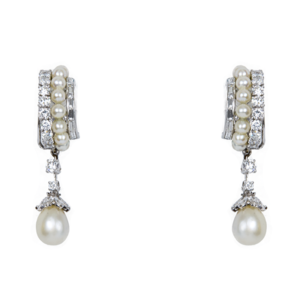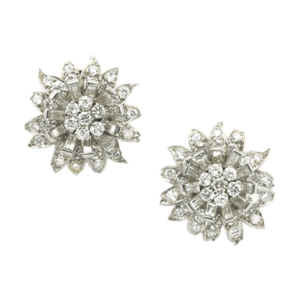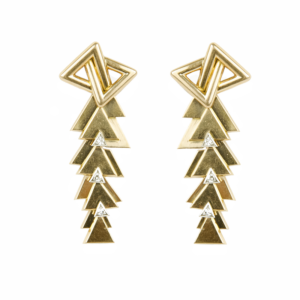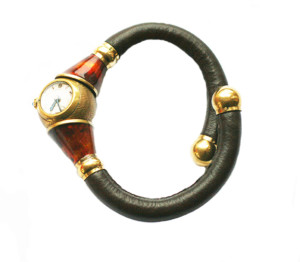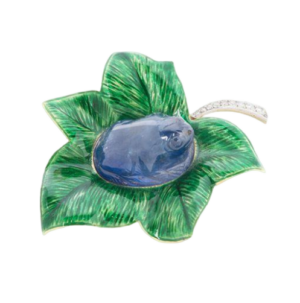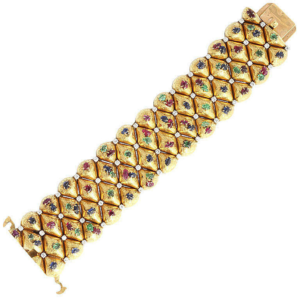(1858-present)
Literature: Raulet, Sylvie. Art Deco Jewelry
While Cartier, Tiffany and Van Cleef & Arpels have become house-hold names in the jewelry world, there were other jewelry houses, especially in France, that produced jewelry of equal beauty and originality. One of these was Boucheron.
The founder, Frédéric Boucheron, was born in 1830. From an early age, Frédéric wanted to be a jeweler. At this time in France, it was not unusual for someone to leave formal schooling at an early age to train at a trade or craft, and by the age of 14, he had already completed his apprenticeship with jeweller Jules Chaise, and soon worked for Tixier-Deschamps, a famous jeweller at the Palais Royal.
In 1858, Boucheron founded his first jewelry store at the Palais Royal, the exclusive quarter for jewelers in Paris during the nineteenth and 20th centuries. Boucheron’s Paris Maison soon became extremely successful, and he exhibited at many expositions, including Philadelphia in 1875 and Paris in 1889.
In 1893, Boucheron moved his jewelry shop to the Place Vendome, also a very exclusive part of Paris. Boucheron was the first jeweler to move his shop to this area, where he soon gained the attention of prestigious clients, including the Comtesse de Castiglione, who was close with the Emperor Napoleon III. Boucheron later opened many jewelry shops, in places such as Moscow and London. Today, the original Boucheron store still exists at the Place Vendome.
Boucheron’s early pieces were very ornate, and consisted of designs including flowery garlands, quivers, arrows, knots and intertwining ribbons. He enjoyed experimenting with new techniques, such as enamel, and was the first jeweler to engrave diamonds. This technique led to the creation of the famous Dragonfly Art Nouveau Pin in 1903, which exemplified the fascination with nature themes that is emblematic of the Art Nouveau movement.
Frédéric was very interested in combining new materials and re – working earlier forms to create his new and striking pieces. Inspired by Egyptian and Asian art, Boucheron was among the first to use formerly unheard-of stone combinations, such as diamonds and onyx, bordered in coral and colored stones, as well as combinations of gold, ivory, and bronze. Boucheron’s utilization of simple materials with rare, precious stones enriched the Art Deco jewelry repertoire.
The brand that Frédéric Boucheron created was carried on by his son, Louis. Louis, like his father, believed in preserving and building upon the strong reputation of the Boucheron name, and continued to deign and produce quality pieces that focused on innovative design and beautiful, fine quality stones.
Louis Boucheron’s designs were inspired by the Art Deco period, which drew inspiration from the emerging Cubist movement, the Ballets Russes, and African Art, which was extremely popular in France prevalent as a result of the Colonial Exhibition in Paris in 1931.
Like his father, Louis became well-known for experimenting with new techniques, especially those pertaining to stones. Louis incorporated rare stones, such as solid blocks of onyx, lapis-lazuli, malachite, turquoise, amber, coral, and jade into his work to create different and striking combinations. He also experimented with new ways to cut stones. This greatly expanded his ability to create contemporary designs. In 1930,
Louis was recognized by the Shah of Iran for his innovative work and knowledge of fine stones, and he was appointed as the expert valuer of the ‘Thousand and one Nights’ treasure.
Louis Boucheron died in 1959, but the Maison Boucheron continued to create jewelry according to the ideals and concepts that it was founded upon.
Masion Boucheron created many different styles of watches, and Boucheron is known as the first jeweler to design the wristwatch that we think of today. Boucheron also created jewelry that was meant to be worn with the “New Look” fashion line by Christian Dior, which had created quite a sensation. These pieces included whimsical brooches in the shape of stars and question marks, as well as many multi – colored pieces.
Eventually, Boucheron became interested in creating pieces that were more delicate in feeling. He began using the chachuté method, where stones were arranged in such a way so as to resemble knots, cascades, and the pistils of a flower. Other techniques were utilized to emphasize delicacy, such as grouping settings together to create clusters. This technique not only yielded delicacy, but also created depth and dimension. Polished and ornamented gold and filigree work were also techniques that Boucheron utilized during this time to create their delicate pieces. The work created during this time illustrates an obvious departure from the previous bold, geometric designs.
In 2000, the Gucci Group purchased the House of Boucheron. Today, Boucheron produces a wider variety of jewelry that is much more affordable, and appeals to a variety of tastes, although it has lost some of its originality. Even though Boucheron is more accessible today, it is still known as one of the most influential jewelry houses of France, and pieces by Boucheron, especially vintage pieces, are highly sought-after.
Showing all 6 results


